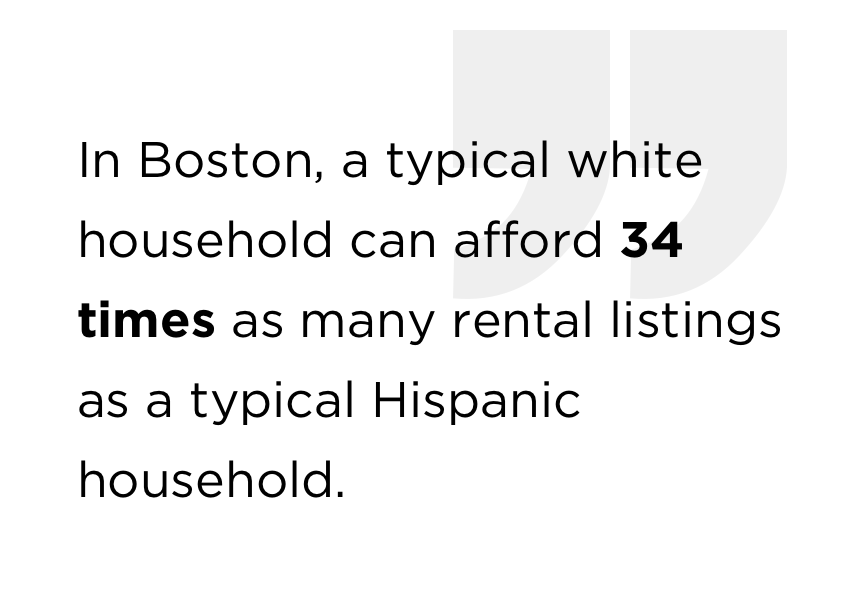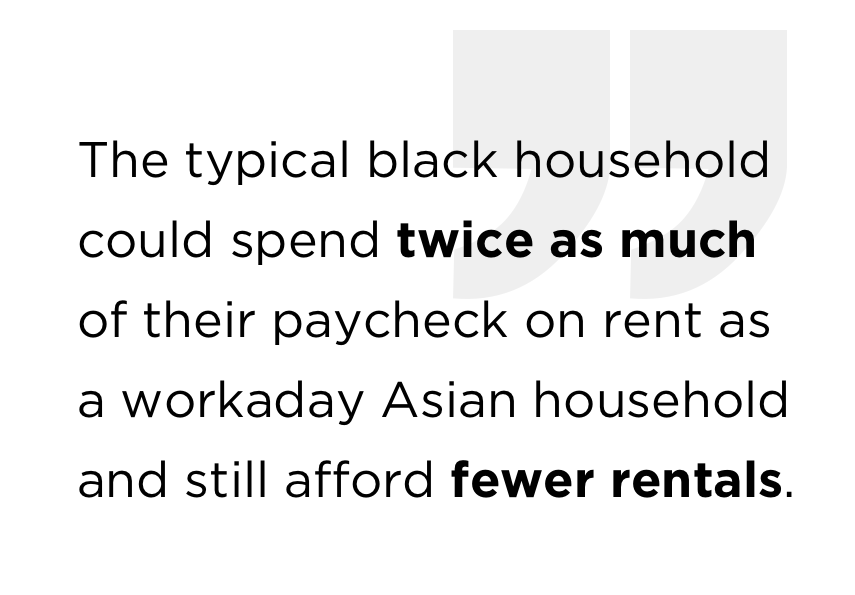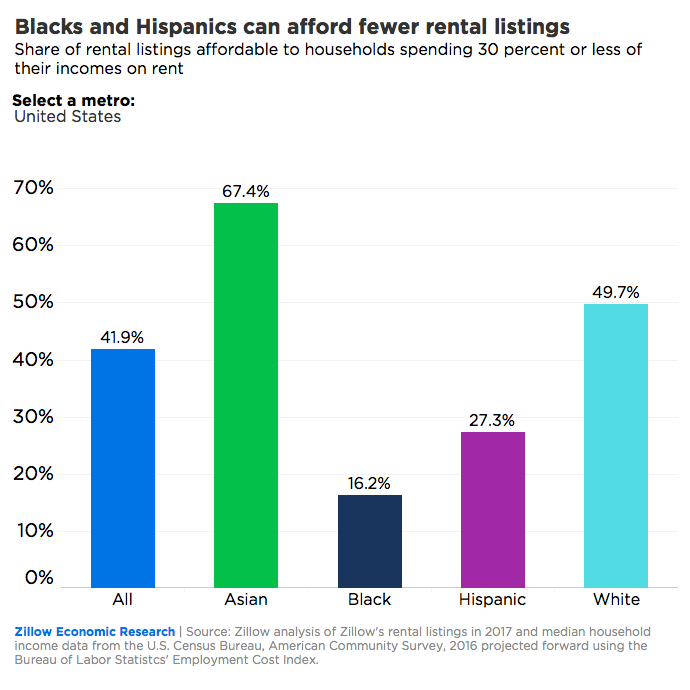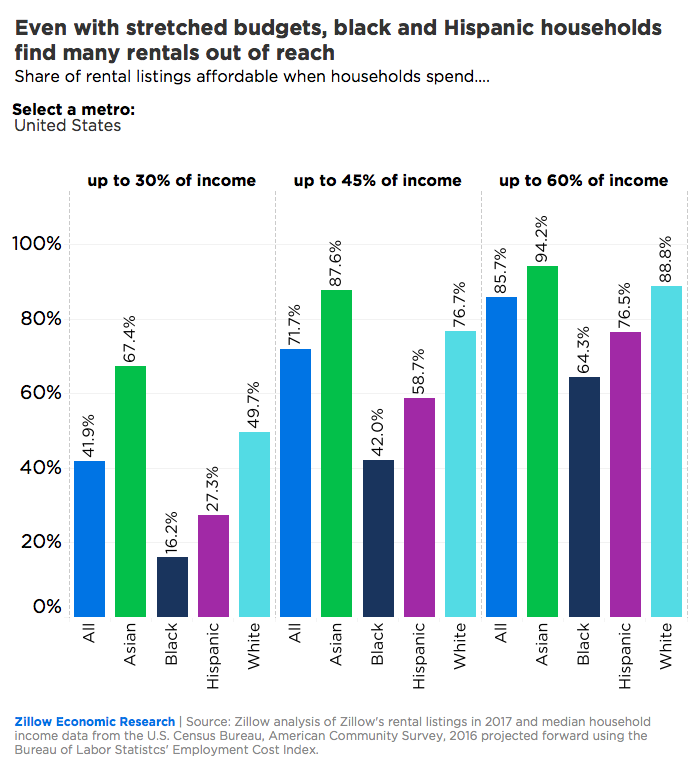A Greater Share of Rentals Are Out of Reach for Blacks, Hispanics
The typical black household could spend twice as much of their paycheck on rent as a workaday Asian household and still afford fewer rentals. In Boston, a typical white household can afford 34 times as many rental listings as a typical Hispanic household.
- In 2017, just 41.9 percent of rental listings that appeared on Zillow were “affordable” for the typical U.S. household, meaning they would have required 30 percent or less of median monthly income.
- Those earning the median black and Hispanic household incomes could afford far fewer rental listings across the U.S. in 2017—just 16.2 percent and 27.3 percent, respectively. By contrast, white and Asian households could afford 49.7 percent and 67.4 percent, respectively, of all rental listings.
- To spend 30 percent of their income on rent, the typical black and Hispanic household has a monthly budget of just $991 and $1,205, respectively. The maximum budget for typical white and Asian households is $1,624 and $2,075.
- If the typical black and Hispanic households were willing to spend up to 45 percent of their income on rent, they would still have had fewer listings to choose from than the typical Asian household spending just 30 percent of income on rent.
Rising rents have put a pinch on many American households’ wallets ever since the housing bubble burst, homeowners lost their homes to foreclosure, and demand for rental homes surged. In 2017, just 41.9 percent of rental listings that appeared on Zillow were “affordable” for the typical U.S. household, meaning they would have required 30 percent or less of median monthly income.
But rents and incomes aren’t equal across metros or racial and ethnic groups. Those earning the median black and Hispanic household incomes could afford far fewer rental homes on the market across the U.S. in 2017—just 16.2 percent and 27.3 percent, respectively. By contrast, white and Asian households could afford 49.7 percent and 67.4 percent, respectively, of all rental listings without spending more than 30 percent of their income on rent. That means that households earning the median white household income could afford three times as many rental listings as households earning the median black household income and nearly twice as many listings as those earning the median Hispanic household income.
The divide comes down to simple math: The rent charged to tenants is largely the same for everyone, regardless of race.
But incomes vary considerably: The typical white household earned $64,944 in 2017; Asian households earned a median annual income of $83,007. The median black and Hispanic household earned just $39,647 and $48,210. Given those income differences, for a black and Hispanic household not to spend more than 30 percent of their income on rent, their maximum budget per month is just $991 and $1,205—well below the $1,624 and $2,075 max budget for a white and Asian household.
Clearly, there is an uneven divide in access to affordable housing by racial and ethnic groups across the United States. But the national figures obscure the fact that racial and ethnic enclaves are clustered in various parts of the country, which inevitably affects income and housing costs. For example, Asians are much more likely to live in some of the large, expensive coastal markets where wages and incomes tend to be higher.
When we compare rental listings with incomes within a metro market, it becomes obvious that the supply of affordable rental listings is even scarcer for many people of color. For example, although at the national level, the typical Asian household can afford a larger share of rental listings than the typical white household, in 13 of the largest 50 metro areas, the white household can afford at least as many rental listings as the typical Asian household.
In fact, in many metros with a large Asian population, Asians could afford fewer rental listings than whites. In Los Angeles, a renter earning the median Asian household income could afford 24.2 percent of all rental listings, whereas a renter earning the median white household income could afford more—31.6 percent of all homes listed for rent on Zillow.
Stark Income Divide by Race Affects Rental Options
In 28 of the largest 50 metros across the country, the white-black income divide is so stark that the typical black household is able to afford fewer than a third of the listings that the typical white household could afford. The gap is largest in many of the notoriously expensive metros, like San Francisco, Los Angeles and Boston.
San Francisco paints a particularly grim picture: The typical black household in San Francisco earns $48,753 and has a maximum “affordable” budget of $1,219; compared to $120,447 and $3,011, respectively, for a white household. To put that in perspective, less than one percent (0.6 percent) of rental listings in the entire San Francisco metro were within the typical black household’s budget, whereas nearly half (49.8 percent) were within budget of the typical white household.
 Similarly, in 42 of the largest 50 metros, the gap between the share of rental listings that the typical Hispanic household could afford and those that the typical white household could afford is wider than the national gap. The large markets with the smallest share of affordable listings for Hispanic households are Boston and New York, where a renter earning the median Hispanic household income could afford just 1.2 percent and 2.7 percent of all rental listings, respectively. The typical white household could afford 34 times as many rental listings in Boston and more than 15 times as many rental listings in New York.
Similarly, in 42 of the largest 50 metros, the gap between the share of rental listings that the typical Hispanic household could afford and those that the typical white household could afford is wider than the national gap. The large markets with the smallest share of affordable listings for Hispanic households are Boston and New York, where a renter earning the median Hispanic household income could afford just 1.2 percent and 2.7 percent of all rental listings, respectively. The typical white household could afford 34 times as many rental listings in Boston and more than 15 times as many rental listings in New York.
Of course, not everyone abides by the 30 percent rule-of-thumb when it comes to the share of income that people put toward housing. Plenty of Americans spend a much larger share of their income on rent, and it’s more the norm than the exception in some expensive markets. However, if the typical black and Hispanic households were willing and able to spend up to 45 percent of their incomes on rent, they still would have had fewer listings to choose from in 2017 than the typical Asian household abiding by the old 30 percent rule-of-thumb: Just 42 percent of all rental listings on Zillow fell below $1,487 in 2017—the dollar amount equivalent to 45 percent of median household income for the typical black household.
Similarly, 58.7 percent of all rental listings would have been within the expanded budget of the typical Hispanic household. Even more shocking is expanding that budget to 60 percent for the typical black household still yields just 64.3 percent of all listed homes— 3.1 percentage-points fewer than Asians sticking with the 30 percent rule-of-thumb. Put another way: the typical black household could spend twice as much of their paycheck on rent as a workaday Asian household and still find fewer rentals within even that wildly bloated budget.
The burden is real for many people of color: The supply and price of available rentals often require them to put more of their income toward housing expenses than whites.
This makes it even more difficult for renters who aspire to own a home one day. As home values rise and rents eat up a larger share of income, saving for a down payment becomes increasingly difficult. Even if they can obtain a down payment, the monthly mortgage payment in many of these large metros also can be a barrier for many households of color. Ultimately, this might prohibit people of color from packing up and leaving their hometowns in search of lucrative job opportunities or social mobility for their families.


 Similarly, in 42 of the largest 50 metros, the gap between the share of rental listings that the typical Hispanic household could afford and those that the typical white household could afford is wider than the national gap. The large markets with the smallest share of affordable listings for Hispanic households are Boston and New York, where a renter earning the median Hispanic household income could afford just 1.2 percent and 2.7 percent of all rental listings, respectively. The typical white household could afford 34 times as many rental listings in Boston and more than 15 times as many rental listings in New York.
Similarly, in 42 of the largest 50 metros, the gap between the share of rental listings that the typical Hispanic household could afford and those that the typical white household could afford is wider than the national gap. The large markets with the smallest share of affordable listings for Hispanic households are Boston and New York, where a renter earning the median Hispanic household income could afford just 1.2 percent and 2.7 percent of all rental listings, respectively. The typical white household could afford 34 times as many rental listings in Boston and more than 15 times as many rental listings in New York.
